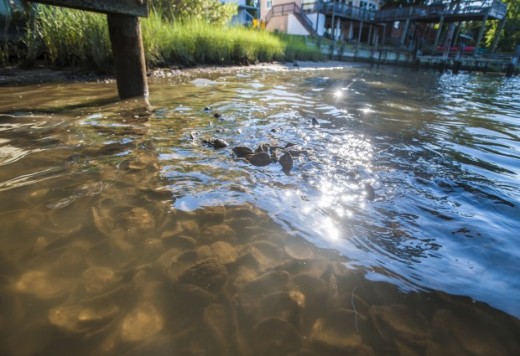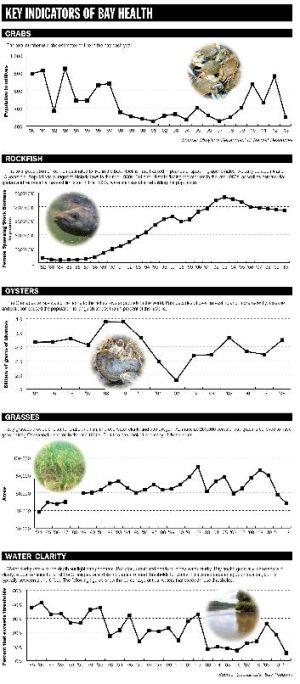Key Indicators of Bay Health +

 Check out the 5 graphs to the right. Too many downtrends, eh?
Check out the 5 graphs to the right. Too many downtrends, eh?
I hope many of you made the time to read some of the series of articles on the Bay appearing in The Capital for 6 consecutive days from the end of last month. If not, treat yourself to something worth knowing more about at this link , (update: this link has been deactivated at capitalgazette.com) including a video for those who’d rather watch than read. Been glad to look back to the series as I hadn’t read as much of it as I thought I should. (Still haven’t emailed editor Steve Gunn to compliment him/staff on the back-to-back-to- series which had to have gotten a lot of notice.)
For you waterfront owners, here’s “What One Man’s Doing to Help the Bay.” And, for anyone, “5 Ways You Can Help ‘Save The Bay’.” Now treat yourself to some excellent, captioned Bay pix, “The Best Images from Troubled Waters.”
Here’s a related piece on the recent, 20th anniversary of a Bay advocacy organization: “The Legacy of the Chesapeake Bay’s Largest Nonprofit.”
Shout-outs: Anniversary or not, another two organizations doing worthy work to restore the Bay are The Severn Riverkeeper and, along the south side of the Annapolis Neck, The South River Federation.
Too, efforts by the Formation Building design/construction team in stormwater runoff management will enhance St. Margaret’s contribution to a healthier Bay, as will many other environmental betterments called for in the LEED regimen. (Update: St. Margaret’s Education/Formation Building will earn 3 LEED points, including Exemplary and Regional Priority, for Stormwater Design-Quality Control.)
Back to solar of the residential kind—as it’s all related. Headline: “Middle-Class Homeowners Lead the Rooftop Solar Revolution.” As reported in the Climate Progress blog: “Solar panels are not limited to wealthy homes — it’s the middle class that is the biggest adopter of solar power in the U.S.” The Center for American Progress (CAP) study it cites reveals that “more than 60 percent of solar installations are occurring in zip codes with median incomes ranging from $40,000 to $90,000.” Considerable controversy arose earlier in the year when Thomas Fanning, CEO of the Southwest regional energy utility, Southern Company, advised stockholders “that if solar customers aren’t paying the utility for the use of the electric grid, then ‘…you in effect have a de facto subsidy of rich people putting solar panels on their roof and having lower-income families subsidize them.”” Some utility companies have started another argument, that customers with solar power systems are not paying their fair share for grid maintenance. What if solar lessens the demand on the grids? Pull the subsidies say those execs. Progressive thinking? What about these same companies getting into the renewable energy business themselves directly or as investors? There are jobs and profits lurking there–without the smokestacks.
In Sundry Department
“5th Annual Trash to Treasure Green Craft Fair” – Saturday, November 9th, 10-4, Watkins Nature Center in Prince George County. Rain/shine. From the Parks & Recreation brochure: “More than 40 local artists will be selling handmade goods crafted from at least 50% recycled, sustainable, organic or fair trade materials. Items include jewelry, wood carvings, hand-crafted gourds, natural fiber products and more!” You can create recycled crafts from members of local non-profit and environmental groups. Something fun for the kids? Fun for the kids-at-heart? Back in June I posted about the kinds of objects that can be crafted from recycled materials. If you missed it, go here.
Catch last night’s headline and pix in The Capital about the return of the Blue Angels? Sequestration has been defeated! An end-around? Tea Party protest welling…?